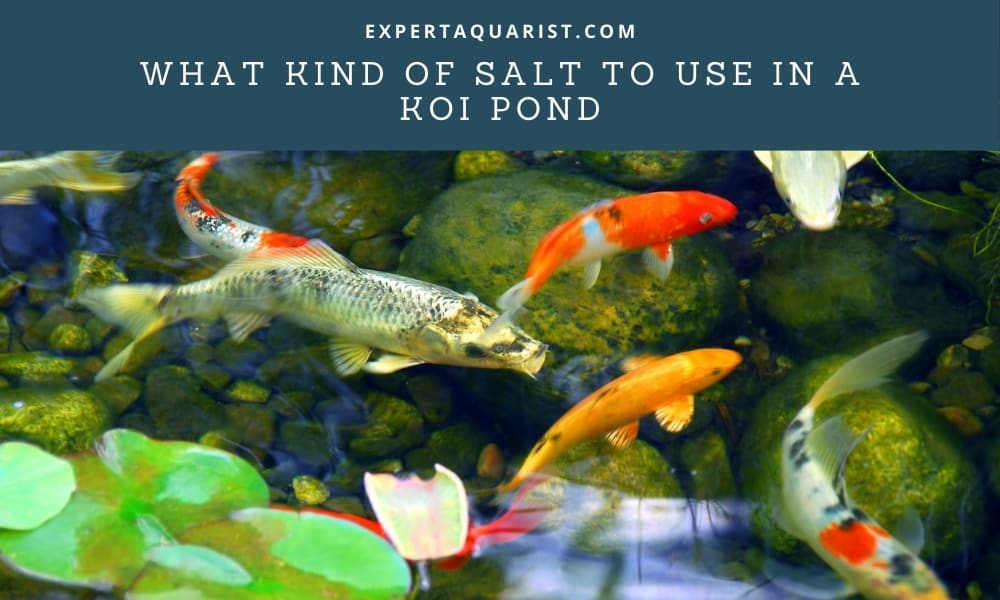It is your sworn duty as a pond owner to keep your fish healthy and happy. Fish like koi need a decent level of babysitting. We need to keep them protected from harmful bacteria, provide comfort in winter, and treat any wounds.
Salt is an affordable solution to all of it.
Simply use tonic salt in your pond as it is not harmful to your fish. Alternatively, using any non-iodized salt in your koi pond is a natural, chemical-free, and risk-free way of protecting the fishes. They’re pocket friendly too!
Alongside explaining what kind of salt to use in a koi pond, I’ll also discuss its importance.
You can learn a lot of helpful stuff here, so stay tuned…
Best kind of salt to use in koi ponds
You can find different types of pond salts in any aquatic or hardware store. But before buying pond salt, you must never select the iodized ones. Iodized salt is not toxic to fish, but it may cause issues to the filtration system. In my opinion, it is better not to take the risk.
Also, make sure that the salt doesn’t have formalin added to it. In both higher and colder temperatures, they can turn toxic for fish. And we know how unstable the global climate is becoming day by day.
Instead of trying to control the temperature through artificial and mechanical means, it’s best to just outright avoid it.
Tonic salt is the best salt for ponds as it has no harmful preservatives and is safe with fish and plants; beneficial bacteria too.

Non-iodized salt and Sodium Chloride are also good options to use in koi ponds. You can also use kosher salt, sea salt, non-iodized table, rock, and ice cream salt. In a word, you can use any salt with no additives.
You should not get the impression that all salt is safe. Avoid common kitchen salt or rock salt as they’re harmful.
Why? because ever so often they’re chemically treated with things like iodine; we can’t afford to have them in our ponds as they could contain toxic elements like cyanide.
Measuring the salt in a pond
It is really crucial to measure out the pond salt because very little won’t be of any use, and too much can be fatal. The standard measurement for pond salt for a koi pond is 1-3 lbs for every 100 gallons.
If you don’t have plants in your pond, it is best to add two and half cups of salt for each 100 gallons of water. But in case you have plants in your fish pond, then that dosage should be lower. I’d recommend you use one and a quarter cups of salt for every 100 gallons of water.
Also, it is better not to salt the pond on a regular basis. You must keep space between the salt treatment. Divide your salting period into 3-4 days for the “little but often” approach.
If you salt the whole pond at once, make sure you do so once and only once. excessive salt can be lethal to fish.
The dosage generally varies from 0.3%-0.6% salt level for the treatment. I’d suggest to start with 0.3% and gradually raise to 0.5% salinity. 0.6% is only recommended when the fishes seem to be very stressed or sick.
Important things to notice before adding salt
Before adding salt to the pond, you need to remove plants, clean the pond and, if possible, lower the water level for a more satisfactory result. It is better not to leave the saltwater too long. After the treatment is done, drain water from the koi pond and replace it with new water.
Place the salt in a bucket and let it dissolve before mixing it into the pond water. If it is not done this way, the salt residue can build up at the bottom and cause burn to the fish by directly coming in contact with them.
Why should we salt the koi pond?
There are many benefits of using salt in a koi pond. Salt is mainly used for creating a defense against bacteria and parasites. People used salt as a go-to solution for parasite related issues before any specific pond treatment was available.
I’ll explain some reasons why using salt in the koi ponds is beneficial:
1. Balancing the organ function of the fishes
Salt protects the fishes in Winter. When the temperature drops and the pond water starts to freeze, the fish’s metabolism will start to get slower and the organs start to function less reactively compared to normal.
Plus, the cold lowers the fish’s natural salt production. Using salt in the pond replaces the natural salt that the fishes usually produce, thus making winter easier and bearable for the fishes.
2. Eliminating parasites and bacteria
Another advantage of using salt in the koi pond is that it eliminates 7 out of 9 parasites frequently found in the pond. Some salt reduces the effects of nitrate toxicity.
Using salt in pond water also stimulates mucus slime coat production. This slime coat gives protection from various parasites, bacteria, and other toxins in the water.
Treating koi
Using salt in a pond is also convenient in treating sick and weak fishes. Koi is a freshwater fish, and the salt level of its body fluid is much higher than the surrounding water. For this reason, water enters into its body and exits as urine.
When a Koi fish is sick or distressed, the osmotic pressure balancing function gets affected. Adding salt to the water gives the fishes relief from the imbalance. It also helps to boost koi’s natural defense against disease.
If your koi are affected by bacteria or parasitic attacks, you’ll have to isolate them in a separate tank filled with pond water. You’d need to add 5 cups of salt per 100 gallons of pond water [Please don’t confuse with tap water].
You’ll monitor the koi in the quarantine tank and see if it needs any further treatment. In most cases, this is enough.
Improves water quality
If you are still asking why you should add pond salt, here’s another point for you to consider. Pond salt improves the overall water quality. It adds beneficial electrolytes to the water, which contributes to physical health- from heart to vision.
No side effects
This is another reason for using salt in koi ponds. Unlike other medicines, adding the right amount of pond salt to the pond is super beneficial and has no side effects on any living things.
Moreover, it is pocket-friendly, which is very reasonable to choose pond salt over any chemical or medicine.
When to use salt to the pond
You need to keep some things in mind before deciding when to use pond salt to the pond. There are a few times when the pond and the fishes need salting.
First, it is better to salt the pond at the beginning of Spring as winter cold weakens the koi’s immune system. Adding salt protects them during this unfortified period.
Adding a pinch of pond salt is also a great idea when the koi are not acting the way they should. A lower dose of salt can be a help for identifying the problem in the koi.
Fishes can act weird for many reasons- water quality, infections, parasites, etc. the lower dose may not resolve the problem but may buy some time for the fishes to recover.
You can also add salt to the pond if you are having a new member of your pond family. Doing so helps to ease the stress from transportation.
Let’s shake some salt
Applying pond salt is really beneficial for the koi and the pond water. But too much salt can kill the underwater greens and do harm the fish itself.
If you maintain the dose and salinity at the right amount, I’m sure you’ll have healthy, strong, and parasite free koi fish and pond.
Hope my writing has given enough info on what kind of salt to use in a koi pond. Apply them and see the change.






